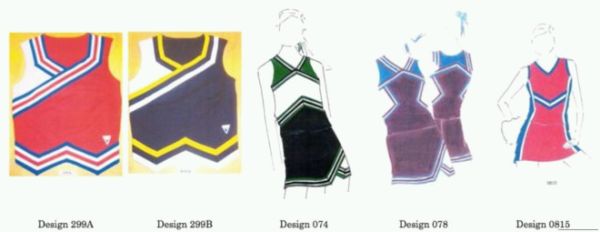In a decision that may have broader implications in the U.S. fashion industry, the U.S. Supreme Court in Star Athletica, L.L.C. v. Varsity Brands, Inc. (No. 15-866) ruled that the decorative elements on a cheerleading uniform can fall within the scope of articles protectable by copyright.
In the decision handed down on March 22, 2017, Justice Thomas, writing for the majority, ruled that the decorative elements on the cheerleading uniforms (shown below) met the threshold requirement of being a "pictorial, graphic, or sculptural work" that can be granted a copyright if the copyrightable elements are sufficiently original and meet other requirements of the Copyright Act. Slip Op. at 10-11.

The Copyright Act does not protect works that are purely "utilitarian," nominally the domain of utility patents. However, when a pictorial, graphic, or sculptural work contains both artistic and utilitarian aspects, copyright protection can exist if the artistic aspects are "conceptually separable" from the utilitarian aspects.
The Court delineated a two-part test for determining whether a feature incorporated into the design of a useful article is eligible for copyright protection:
(1) can the feature be perceived as a two- or three-dimensional work of art separate from the useful article and;
(2) would the feature qualify as a protectable pictorial, graphic, or sculptural work—either on its own or fixed in some other tangible medium of expression—if it were imagined separately from the useful article into which it is incorporated.
Slip Op. at 1-2.
As to the first part of the test of "separate identification," the Court indicated that this evaluation is "not onerous." Justice Thomas said that "[t]he decisionmaker need only be able to look at the useful article and spot some two- or three-dimensional element that appears to have pictorial, graphic, or sculptural qualities." Slip Op. at 7.

The second "independent existence" part of the test requires a more arduous analysis. In discussing the parameters of this part of the test, the Court reviewed its seminal case on the issue, Mazer v. Stein, 347 U. S. 201 (1954), which held the lamp base (shown to the left) could have been protected by copyright as a stand-alone article despite the fact that it was first created as part of a useful article. Slip Op. at 9.
In examining the cheerleading uniforms, the Court imagined the decorative elements as two-dimensional works of art, namely, mere surface decorations which could be extracted from the useful article of clothing on which they were printed. The fact that the two-dimensional decorative elements of the cheerleading uniforms retained the outline of the cheerleading uniform did not bar copyright protection. Justice Thomas analogized to a guitar with its surface painted, where the two-dimensional painting on the guitar can be "imaginatively removed" from the guitar, while still retaining the guitar shape. Slip. Op. at 11.
The Court concluded that the decorative elements of cheerleading uniform designs were artistic works expressed on a medium of uniform fabric, and, thus, could be protected by copyright. Slip Op. at 12. This, of course, does not answer the question of whether these particular designs pass the "originality" test for copyrightability. That issue is yet to be decided by the lower courts.
Justice Breyer in dissent noted the many times Congress declined to extend broad copyright protection to the fashion design industry. Slip Op., Breyer, J., dissenting at 8. Fashion designers already had multiple tools for protection of their intellectual property at their disposal, including design patents, trademark protection, and copyrights for original textile designs place on a bolt of cloth. Slip Op., Breyer, J., dissenting at 9.
The fashion design industry should be encouraged by the Supreme Court's decision that could extend copyright protections much further than previously allowed. However, as the Court emphasized, this case only examined the threshold question of whether these uniforms could fall within one of the categories of works that could be protected by copyright. The "originality" of a fashion design seeking copyright protection will certainly be an issue. Moreover, copyright protection for fashion design may bring a double-edged sword: while fashion designers may be inspired by current and past creations, they will need to be careful to avoid creating derivative works that infringe other designers' copyright protection. Since copyright protection has a very long life, the unintended fallout is not insignificant.
The content of this article is intended to provide a general guide to the subject matter. Specialist advice should be sought about your specific circumstances.


